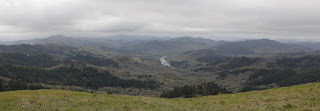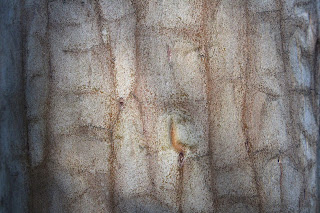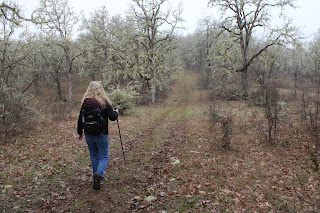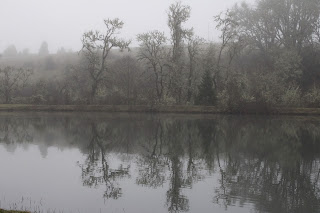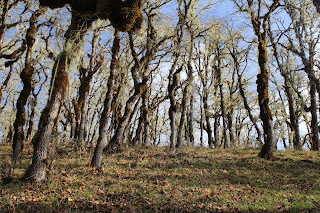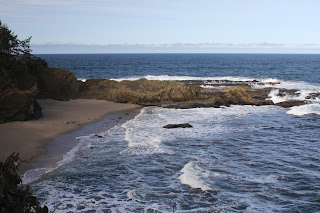Take a bowl of spaghetti soaked in red marinara sauce, flip it upside down on a white tablecloth, and voila, you'll have your very own rendition of a Jacksonville Forest Park trail map. And do make sure to clean up the mess before the wife gets home! Messy culinary metaphor aside, the point I'm trying to make is that trails proliferate everywhere in the esteemed woodland park, filling the map with squiggles that resemble a ball of wriggling baby snakes (or bowl of spaghetti) more than a network of well-used footpaths. There are so many paths, routes, and junctions that the very idea of leading a hiking group there would (and should) fill one with trepidation. Appropriately enough, Lane (the designated hike leader for this Friends of the Umpqua outing) was justifiably trepidated.
 |
| A flock of Eagles and Monkeys gather in the forest |
Glenn and I had hiked this route just a couple of weekends prior to the official Friends of the Umpqua hike, so I'm not going to rehash the hiking thereof since the club hike was the same route described in my prior blog entry. However, the complexity of the hike presented a degree of difficulty not normally encountered because on our chosen route there were at least 38 trail intersections presenting 38 opportunities to peel inattentive hikers away from the group. Unique challenges require unique solutions, so we'll talk about those instead.
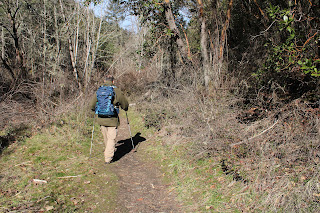 |
| Chuck leads the Turtle charge, such as it is |
Because Lane, Glenn, and yours truly were familiar with the route, the 17-member group was partitioned into three teams, based on hiking speed. In order of anticipated rapidity (or lack thereof) the teams were named after animals: Eagle, Monkey, and Turtle; and stickers were handed out to all hikers like so many kindergartners on a field trip. And guess who was in charge of Team Turtle? In response to the cruel japery directed my way by those who felt superior to our slow but mighty team because they could walk faster, I could only remind them that it was a turtle that had won the race against the hare.
 |
| A rolling stone gathers no moss, but standing trees on the other hand, do |
Two-way radios were distributed to two leaders in each team (except for the Turtles) and all leaders were assigned code names: Eagle Beak, Eagle Claw, Monkey See, Monkey Do, and Turtle Head. Additionally, each team leader was given a list of check-in and regroup points and I must say, the whole system worked quite well other than the many turtle insults broadcast over the public radiosphere. I chose not to respond in kind and just retreated into my shell.
 |
| Jacksonville Creek had some water in it |
Because I had been here just a couple of weeks prior, I noticed Jackson Creek was carrying a bit more water this time out, thanks to some intervening rain. As always, I had my trusty camera with me but really, I didn't take a lot of pictures, preferring instead to concentrate on my duties as chief turtle herder and overall hike sweep.
 |
| An oak, uncertain about which direction to grow |
As the hike wore on and the trail trended towards the uphill, some hikers dropped into the next slower group down and accordingly, I soon acquired more turtles in our bale and yes, a group of turtles is really called a bale. At any rate, I preferred to think of the neo-Turtles that were former Monkeys as Turkeys.
 |
| Manzanita was in bloom on Upper Twin Peak summit |
One of our regroup points was atop Upper Twin Peak where we fed the animals, so to speak. We ate lunch on the wooded summit while soaking in the view of Mt. McLaughlin and Bear Creek Valley, enjoying the hiking camaraderie, and denigrating all things turtle. With so many hikers all chatting and chomping atop the summit, it was quite the zoo. The main thing for the three team leaders was that all hikers were present and accounted for. So far, so good.
 |
| Lichen clings to life on a tree trunk |
The good news from a hiking standpoint was that after the summit of Upper Twin Peak, the route was all downhill, causing some of the Turkeys to self-promote back up to Monkey rank. As an aside, the Monkeys were indeed pretty rank all right, but that's another story.
 |
| A maple leaf, about to get devoured by moss |
It was a pretty satisfied and happy group that last gathered at the trailhead for a final head count when the hike was over. In speaking to some of the participants post-hike, the consensus seemed that as the hike started, there was much grumbling and talk of mutiny because of the stultifying team hiking rules and regulations. However, after the first several dozen trail intersections or so within the first set of miles, everybody saw the need for being organized and all would-be rebellious types soon became happily compliant. Should have named that group Team Sheep.
 |
| I wear my badges with honor |
My only complaint about the whole outing is that apparently, my new trail name is now Turtle Head. Not sure I particularly like that, I'd gladly shed my turtle shell, but then I'd either be homeless or naked and not really sure which.
 |
| Quite the menagerie |
For more photos of this hike, please visit the Flickr album.







